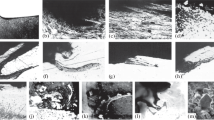Abstract
Assessment of the wear resistance in wheel–rail contact by determining the tribological characteristics of high-carbon steel in dry friction is proposed. Comparative test results are presented for such steel, as well as for hardened layers of wheel steel with optimal plasma surface hardening and different carbon and chromium contents. The wear resistance of the working surfaces of high-carbon wheel and rail steels in dry friction and abrasion is determined. The plasma hardening of locomotive wheel pairs with increased hardness of the outer wrap and one-piece freight-car wheels made from chrome steel is optimized. The change in wear resistance is confirmed in abrasive-wear tests. Test results for carbon and high-carbon steels are compared, as well as results for layers after plasma powder surfacing and plasma surface hardening.
Similar content being viewed by others
References
Lysyuk, V.S., Prichiny i mekhanizmy skhoda kolesa s rel’sa. Problema iznosa koles i rel’sov (The Reasons and Mechanisms of the Wheel Descent from the Rail. A Problem of Wear of the Wheels and Rails), Moscow: Transport, 2002, 2nd ed.
Luzhnov, Yu.M., Stseplenie koles s rel’sami (priroda i zakonomernosti) (Grip of the Wheels and Rails: Nature and Principles), Moscow: Intekst, 2003.
Bogdanov, V.M., Reduction of wear intensity of the wheel flanges and lateral wear of the rails, Zheleznodorozhn. Transp., 1992, no. 12, pp. 30–34.
Bogdanov, V.M., Goryachev, A.P., Goryacheva, I.G., et al., Modeling of the contact, wear, and accumulation of damages in the grip of the wheel and rail, Trenie Iznos., 1996, vol. 17, no. 1, pp. 12–19.
Isakaev, E.Kh., Mordynskii, V.B., Pen’kova, G.I., et al., The effect of tension concentrators on the stability properties of the rail steel, Tekhnol. Mashinostr., 2012, no. 3, pp. 5–8.
Gontaruk, E.I., Il’ichev, M.V., Isakaev, E.Kh., Tyuftyaev, A.S., and Filippov, G.A., Surface plasma hardening of steel parts, Steel Transl., 2002, vol. 32, no. 6, pp. 78–81.
Isakaev, E.Kh., Il’ichev, M.V., Tyuftyaev, A.S., and Filippov, G.A., Specific features of structure and formation of properties at the plasma treatment of carbon steel, Materialovedenie, 2003, no. 2, p. 52.
Bogdanov, V.M., Markov, D.P., and Pen’kova, G.I., Optimization of tribological characteristics of the wheel flanges of the rolling-stock, Vestn. Vseross. Nauchno-Issled. Inst. Zheleznodorozhn. Transp., 1998, no. 4, pp. 3–9.
Isakaev, E.Kh., Mordynskii, V.B., Tyuftyaev, A.S., and Pen’kova, G.I., Wear resistance of modified surfaces of the wear pair wheel–rail, Tekhnol. Mashinostr., 2013, no. 12, pp. 36–39.
Tyuftyaev, A.S., Mordynskii, V.B., Zhelobtsov, E.A., and Il’ichev, M.V., Influence of the parameters of surface plasma treatment of the 60G steel on tribological characteristics of the reinforced layer: a guide, Inzh. Zh., 2014, no. 11, pp. 6–12.
Author information
Authors and Affiliations
Corresponding author
Additional information
Original Russian Text © A.S. Tyuftyaev, V.B. Mordynskii, E.A. Zhelobtsov, 2015, published in “Stal’,” 2015, No. 10, pp. 55–60.
About this article
Cite this article
Tyuftyaev, A.S., Mordynskii, V.B. & Zhelobtsov, E.A. Wear resistance of high-carbon steel with dry friction and abrasion. Steel Transl. 45, 796–802 (2015). https://doi.org/10.3103/S0967091215100174
Received:
Published:
Issue Date:
DOI: https://doi.org/10.3103/S0967091215100174




